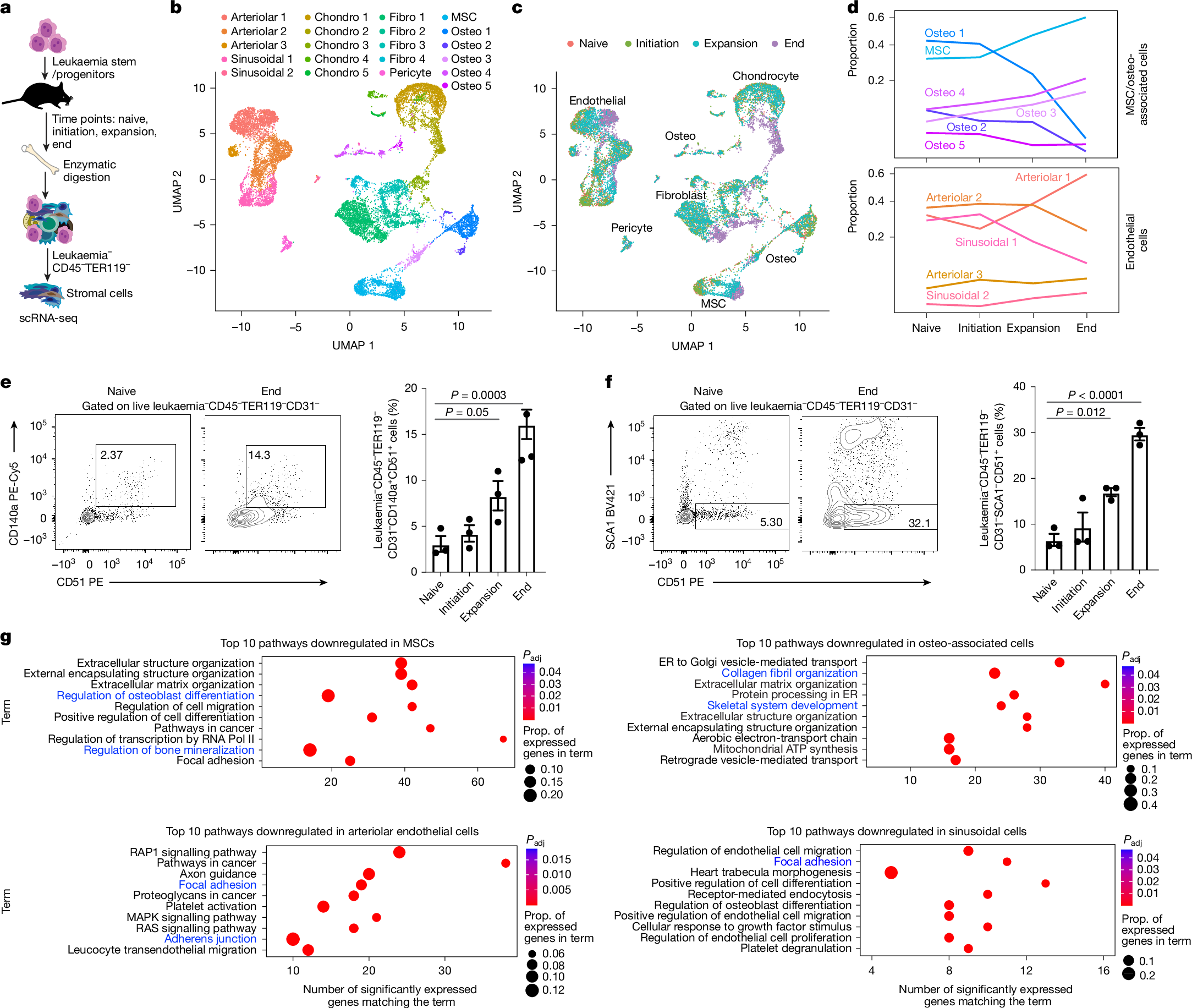dx.doi.org/10.1038/s41586-025-09018-7
Preview meta tags from the dx.doi.org website.
Linked Hostnames
42- 246 links todx.doi.org
- 144 links towww.ncbi.nlm.nih.gov
- 74 links toscholar.google.com
- 73 links todoi.org
- 23 links toscholar.google.co.uk
- 23 links towww.nature.com
- 19 links tostatic-content.springer.com
- 17 links togithub.com
Thumbnail

Search Engine Appearance
Taurine from tumour niche drives glycolysis to promote leukaemogenesis - Nature
Signals from the microenvironment are known to be critical for development, stem cell self-renewal and oncogenic progression. Although some niche-driven signals that promote cancer progression have been identified1–5, concerted efforts to map disease-relevant microenvironmental ligands of cancer stem cell receptors have been lacking. Here, we use temporal single-cell RNA-sequencing (scRNA-seq) to identify molecular cues from the bone marrow stromal niche that engage leukaemia stem-enriched cells (LSCs) during oncogenic progression. We integrate these data with our human LSC RNA-seq and in vivo CRISPR screen of LSC dependencies6 to identify LSC–niche interactions that are essential for leukaemogenesis. These analyses identify the taurine–taurine transporter (TAUT) axis as a critical dependency of aggressive myeloid leukaemias. We find that cysteine dioxygenase type 1 (CDO1)-driven taurine biosynthesis is restricted to osteolineage cells, and increases during myeloid disease progression. Blocking CDO1 expression in osteolineage cells impairs LSC growth and improves survival outcomes. Using TAUT genetic loss-of-function mouse models and patient-derived acute myeloid leukaemia (AML) cells, we show that TAUT inhibition significantly impairs in vivo myeloid leukaemia progression. Consistent with elevated TAUT expression in venetoclax-resistant AML, TAUT inhibition synergizes with venetoclax to block the growth of primary human AML cells. Mechanistically, our multiomic approaches indicate that the loss of taurine uptake inhibits RAG-GTP dependent mTOR activation and downstream glycolysis. Collectively, our work establishes the temporal landscape of stromal signals during leukaemia progression and identifies taurine as a key regulator of myeloid malignancies. The taurine–taurine transporter axis is a critical dependency of aggressive myeloid leukaemias.
Bing
Taurine from tumour niche drives glycolysis to promote leukaemogenesis - Nature
Signals from the microenvironment are known to be critical for development, stem cell self-renewal and oncogenic progression. Although some niche-driven signals that promote cancer progression have been identified1–5, concerted efforts to map disease-relevant microenvironmental ligands of cancer stem cell receptors have been lacking. Here, we use temporal single-cell RNA-sequencing (scRNA-seq) to identify molecular cues from the bone marrow stromal niche that engage leukaemia stem-enriched cells (LSCs) during oncogenic progression. We integrate these data with our human LSC RNA-seq and in vivo CRISPR screen of LSC dependencies6 to identify LSC–niche interactions that are essential for leukaemogenesis. These analyses identify the taurine–taurine transporter (TAUT) axis as a critical dependency of aggressive myeloid leukaemias. We find that cysteine dioxygenase type 1 (CDO1)-driven taurine biosynthesis is restricted to osteolineage cells, and increases during myeloid disease progression. Blocking CDO1 expression in osteolineage cells impairs LSC growth and improves survival outcomes. Using TAUT genetic loss-of-function mouse models and patient-derived acute myeloid leukaemia (AML) cells, we show that TAUT inhibition significantly impairs in vivo myeloid leukaemia progression. Consistent with elevated TAUT expression in venetoclax-resistant AML, TAUT inhibition synergizes with venetoclax to block the growth of primary human AML cells. Mechanistically, our multiomic approaches indicate that the loss of taurine uptake inhibits RAG-GTP dependent mTOR activation and downstream glycolysis. Collectively, our work establishes the temporal landscape of stromal signals during leukaemia progression and identifies taurine as a key regulator of myeloid malignancies. The taurine–taurine transporter axis is a critical dependency of aggressive myeloid leukaemias.
DuckDuckGo
Taurine from tumour niche drives glycolysis to promote leukaemogenesis - Nature
Signals from the microenvironment are known to be critical for development, stem cell self-renewal and oncogenic progression. Although some niche-driven signals that promote cancer progression have been identified1–5, concerted efforts to map disease-relevant microenvironmental ligands of cancer stem cell receptors have been lacking. Here, we use temporal single-cell RNA-sequencing (scRNA-seq) to identify molecular cues from the bone marrow stromal niche that engage leukaemia stem-enriched cells (LSCs) during oncogenic progression. We integrate these data with our human LSC RNA-seq and in vivo CRISPR screen of LSC dependencies6 to identify LSC–niche interactions that are essential for leukaemogenesis. These analyses identify the taurine–taurine transporter (TAUT) axis as a critical dependency of aggressive myeloid leukaemias. We find that cysteine dioxygenase type 1 (CDO1)-driven taurine biosynthesis is restricted to osteolineage cells, and increases during myeloid disease progression. Blocking CDO1 expression in osteolineage cells impairs LSC growth and improves survival outcomes. Using TAUT genetic loss-of-function mouse models and patient-derived acute myeloid leukaemia (AML) cells, we show that TAUT inhibition significantly impairs in vivo myeloid leukaemia progression. Consistent with elevated TAUT expression in venetoclax-resistant AML, TAUT inhibition synergizes with venetoclax to block the growth of primary human AML cells. Mechanistically, our multiomic approaches indicate that the loss of taurine uptake inhibits RAG-GTP dependent mTOR activation and downstream glycolysis. Collectively, our work establishes the temporal landscape of stromal signals during leukaemia progression and identifies taurine as a key regulator of myeloid malignancies. The taurine–taurine transporter axis is a critical dependency of aggressive myeloid leukaemias.
General Meta Tags
214- titleTaurine from tumour niche drives glycolysis to promote leukaemogenesis | Nature
- titleClose banner
- titleClose banner
- X-UA-CompatibleIE=edge
- applicable-devicepc,mobile
Open Graph Meta Tags
6- og:urlhttps://www.nature.com/articles/s41586-025-09018-7
- og:typearticle
- og:site_nameNature
- og:titleTaurine from tumour niche drives glycolysis to promote leukaemogenesis - Nature
- og:descriptionThe taurine–taurine transporter axis is a critical dependency of aggressive myeloid leukaemias.
Twitter Meta Tags
6- twitter:site@nature
- twitter:cardsummary_large_image
- twitter:image:altContent cover image
- twitter:titleTaurine from tumour niche drives glycolysis to promote leukaemogenesis
- twitter:descriptionNature - The taurine–taurine transporter axis is a critical dependency of aggressive myeloid leukaemias.
Item Prop Meta Tags
4- position1
- position2
- position3
- publisherSpringer Nature
Link Tags
15- alternatehttps://www.nature.com/nature.rss
- apple-touch-icon/static/images/favicons/nature/apple-touch-icon-f39cb19454.png
- canonicalhttps://www.nature.com/articles/s41586-025-09018-7
- icon/static/images/favicons/nature/favicon-48x48-b52890008c.png
- icon/static/images/favicons/nature/favicon-32x32-3fe59ece92.png
Emails
1Links
688- http://adsabs.harvard.edu/cgi-bin/nph-data_query?link_type=ABSTRACT&bibcode=1992PNAS...8912145L
- http://adsabs.harvard.edu/cgi-bin/nph-data_query?link_type=ABSTRACT&bibcode=1992Sci...258..468Z
- http://adsabs.harvard.edu/cgi-bin/nph-data_query?link_type=ABSTRACT&bibcode=2007PNAS..10411008H
- http://adsabs.harvard.edu/cgi-bin/nph-data_query?link_type=ABSTRACT&bibcode=2008Sci...320.1496S
- http://adsabs.harvard.edu/cgi-bin/nph-data_query?link_type=ABSTRACT&bibcode=2010Natur.466..765I